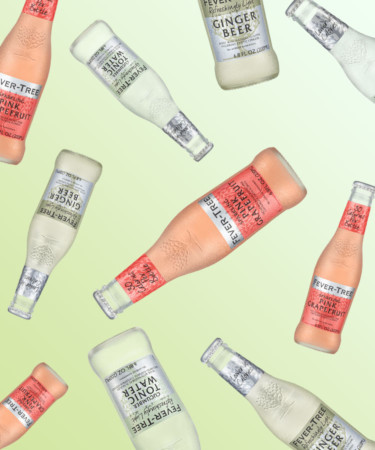Initially made to complement gins of all kinds, Fever-Tree launched a line of premium tonic waters that revolutionized the beverage industry in 2004. Sure, there were many other mixer brands already on the scene, but Fever-Tree’s products stood apart from the rest — aiming to be just as pleasurable to sip on their own as they are mixed into cocktails.
The idea was sparked when Tim Warrillow, a former advertising executive with hopes of opening a gin distillery of his own, reached out to Charles Rolls, a veteran in the gin industry who had previously worked with Plymouth Gin. But after meeting, the conversation between the two quickly turned to the classic Gin and Tonic. A quick deep dive into the cocktail’s famed mixer prompted the two entrepreneurs to create tonic water that was deserving of quality gins.
Research led them to the Democratic Republic of Congo, where they sourced the high-quality quinine that would be the foundation of their premium tonic waters. With a taste that is rooted in natural ingredients including botanicals and essential oils from fruit, Fever-Tree has become one of the top premium mixers for tonic-based cocktails, Mules, and now cola-based rum and whiskey cocktails in the span of just a few years.
Here are eight more things to know about Fever-Tree
The Fever-Tree name is simple yet meaningful.
Though all tonic water is made with quinine, Fever-Tree is uniquely produced with quinine from original Cinchona ledgeriana trees, locally known as fever trees. So, when choosing a name for their new line of mixers, owners Rolls and Warrillow opted to put the liquid’s key ingredient first and pay homage to its origin.
Fever-Tree offers a wide range of tonics for gin drinkers.
With eight different flavors, there is a Fever-Tree tonic for every kind of G&T or Vodka Tonic lover. The Premium Indian Tonic Water — which references the introduction of tonic water in India by Europeans who used it medicinally to aid in reducing fevers caused by Malaria — or the Citrus flavor best suits those looking for the cocktail’s classic, balanced taste of bitterness and citrus, while the Elderflower and Cucumber flavors perfectly complement gin’s juniper botanical notes. For an interesting approach, drinkers can opt for the Mediterranean flavor, which incorporates essential oils from flowers and Mediterranean herbs like lemon thyme.
Not just a one-trick pony, Fever-Tree wants to perfect all your favorite cocktails.
After crafting the perfect gin mixer, the folks at Fever-Tree set their sights on perfecting other popular bar mixers, such as ginger ale and club soda. Today, the lineup includes a premium crafted ginger beer, a spiced orange ginger ale, and a variety of sparkling waters with zippy flavors like pink grapefruit and sparkling lime-yuzu.
During the summer of 2021, the brand also released its Distillers Cola, a mixer designed to be paired with whiskey and rum.
Its ingredients are sourced from all over the world.
Fever-Tree uses quality natural ingredients sourced from locations around the globe. While the aforementioned quinine is sourced from the Democratic Republic of Congo, three types of ginger — hailing from the Ivory Coast, Nigeria, and Cochin, India — are used in making the brand’s ginger-based mixers. The additional fruits and spices that flavor Fever-Tree products, like Tahitian key limes, Madagascar vanilla, and Sri Lankan cinnamon, are also sourced from faraway locales. Most Fever-Tree products contain cane sugar, but their “Refreshingly Light” line of mixers uses fruit sugar.
Fever-Tree is fighting the good fight against malaria.
Originally used for medicinal purposes, quinine has a deep history of fighting malaria — and Fever-Tree wants it to stay that way. Since 2013, the London-based brand has been a prominent supporter of Malaria No More, a U.K.-based non-profit whose mission is to eradicate Malaria. With its clever social media campaign — Raise a Glass to Fight Malaria — Fever-Tree raised $203,946 for the cause in 2018.
Need ideas? Look no further than Fever-Tree’s cocktail books.
Whether you’re short on inspiration or just looking for new ways to spice up your favorite cocktail, Fever-Tree’s cocktail books are the perfect guides. Originally released in 2017, “Fever-Tree: The Art of Mixing” guides readers through cocktails by focusing on popular mixers rather than spirits. In its second book, the brand offers readers 150 cocktails and mixed drinks that can be speedily made, no matter the home bartender’s skill level (or lack thereof).
The brand is rooted in sustainable practices.
From its ingredients to its packaging, sustainability has been a priority at Fever-Tree since its debut. With most of its ingredients sourced from small farms and plantations, the brand has implemented environmental systems to manage pollution, water, energy, and emissions to minimize its carbon footprint. With a mission to connect people to nature, Fever-Tree has also partnered with Earthwatch Europe to plant a Tiny Forest in London’s Hammersmith Park. Together, they are bringing forestry back to urban spaces and creating a haven where the city’s natural wildlife can thrive.
It’s an industry favorite.
Attention to detail and fresh ingredients helped Fever-Tree become a favorite in bars and homes alike. Whether you’re making the perfect Gin and Tonic, or a well-made vodka cocktail, bartenders and enthusiasts widely recognize the quality Fever-Tree mixers bring to cocktails.
